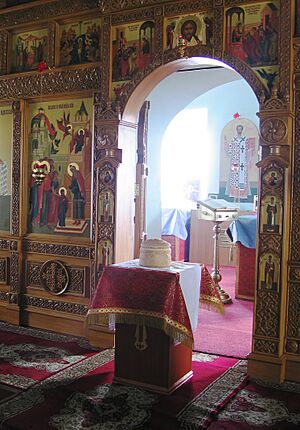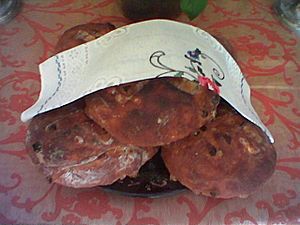Artos facts for kids
| This article contains special characters. Without proper rendering support, you may see question marks, boxes, or other symbols. |
An artos (Ancient Greek: Ἄρτος) is a special loaf of leavened bread. It is blessed during church services in the Eastern Orthodox and Byzantine Catholic churches.
A large Artos is baked for Pascha (Easter). It often has a picture of Jesus's resurrection on top. Smaller loaves are blessed during evening prayers (called Vespers) in a special service called Artoklasia. They are also used for holidays, weddings, and memorial services.
Contents
What "Artos" Means
The word Artos comes from Ancient Greek. It used to mean "cake" or "bread." In Modern Greek, the word "Artos" is mostly used for church bread. The common word for bread today is psomi.
The Easter Artos
The Easter Ritual
Near the end of the Easter Vigil service, a large loaf of Artos is brought to the priest. This special bread often shows a cross with a crown of thorns, or a picture of Christ's Resurrection. The Artos reminds people that the resurrected Christ is present among them.
The priest blesses the Artos with a special prayer. He also sprinkles it with Holy Water. The Artos then stays on a small table in front of the Iconostasis for all of Bright Week. Bright Week is the week after Easter. When people enter the church, they often kiss the Artos. This is a way to greet the Risen Christ.
Every day during Bright Week, after the Divine Liturgy (or morning prayers), the Artos is carried in a special procession. This procession goes around the outside of the church.
In monasteries, the Artos is taken to the dining hall (called the Trapeza) every day of Bright Week. At the end of the festive meal, there is a ceremony called the Lifting of the Artos. The person leading the ceremony lifts the Artos. This symbolizes Christ's Resurrection. They say, "Christ is Risen!" Everyone replies, "He is truly Risen!" Then, two Easter hymns are sung. Everyone comes forward to kiss the Artos and receive a blessing.
On Bright Saturday, after the Divine Liturgy, the priest says another prayer over the Artos. Then, the Artos is broken into pieces. These pieces are given to everyone in the church, along with the Antidoron.
Why the Artos is Important
The Artos helps Christians remember the events of Jesus Christ's Resurrection. Jesus called Himself the "Bread of Life." He said, "I am the bread of life; he who comes to Me shall not hunger, and He who believes in Me shall never thirst" (John 6:35).
After Jesus rose from the dead, He appeared to His disciples many times. He ate with them and blessed their food. For example, on the first day He rose, two disciples recognized Him in Emmaus when He blessed and broke bread (Luke 24:13-35).
Forty days after His Resurrection, Jesus went up to heaven. His followers found comfort in remembering Him. They recalled His words and actions. When they prayed together, they shared the Body and Blood of Christ. This reminded them of the Last Supper. When they ate regular meals, they would leave an empty spot at the table for Jesus. They would also place bread there, remembering His invisible presence.
The early Church leaders remembered this custom of the Apostles. So, they started putting out the Artos during the Easter celebration. This reminds everyone of Jesus appearing to His disciples after He rose. It also reminds us that Jesus is the true Bread of Life. He is always present in His church (Matthew 28:20).
The Artos can also be compared to the unleavened bread in the Old Testament. The people of ancient Israel ate this bread after they were freed from Egypt (Ex. 12:15-20). A bishop named Cyril of Turov, who lived in Russia in the 1100s, explained this. He said that just as the Jews carried their bread after leaving Egypt, Christians carry the blessed Artos. Eating it helps keep our bodies and souls healthy.
Many Russian Orthodox Christians still keep a piece of the Artos all year. They eat it with respect and faith when they are sick or troubled. They often eat it with Holy Water that was blessed during the Feast of the Theophany.
Artoklasia
On special feast days, near the end of vespers (evening prayers), there is a blessing of loaves, wheat, wine, and oil. The priest then breaks one of the loaves. This action gives the rite its name: Artoklasia, which means "breaking of bread."
The loaves for Artoklasia can have a special stamp on them before baking. This is similar to the Prosphora used for the Divine Liturgy. The stamp might show an Icon of a saint or a simple cross. It might also have a prayer, like "May the Blessing of the Lord be upon us. Amen."
See Also



